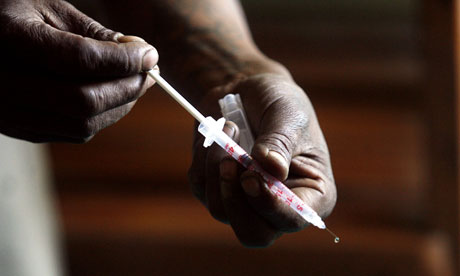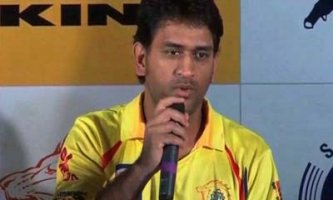September 11, 2012
Abuse of synthetic opioids and prescription drugs is one of the fastest growing problems in India. Use of heroin and cocaine continues to drop, due to the fact that pharmaceutical drugs are often 10 times less expensive.

An unidentified Indian Injected Drug User
September 11, 2012
Abuse of synthetic opioids and prescription drugs is one of the fastest growing problems in India. Use of heroin and cocaine continues to drop, due to the fact that pharmaceutical drugs are often 10 times less expensive.

An unidentified Indian Injected Drug User
UN says fall in heroin and cocaine use cloaks rising addiction to man-made opiates and prescription drugs by middle classes
Jahangarpuri is the end of the line, the shiny new metro in India's capital city stops here. Beyond are the ragged edges of the city and dusty farmland.
Satish has been coming to Jahangarpuri for two years. Every morning the 28-year-old squats in the stinking patch of wasteland used by local slum-dwellers as a toilet and injects himself with a needle picked up from among the filth. He says his family in an exclusive suburb on the other side of the city have disowned him but the drugs coursing through his veins render him incoherent before he can say much more. Satish recently switched from heroin to a cocktail of pharmaceutical substitutes.
According to the United Nations Office on Drugs and Crime's recently released World Drug Report 2011, stable or downward trends for heroin and cocaine use in major regions of consumption worldwide are being offset by increases in the use of synthetic and prescription drugs. The use of prescription drugs such as the synthetic opioids and sedatives used by Satish is one of the fastest growing – and least reported – problems in India and other developing countries.
"There are more and more. We have a thousand or more users registered with us," said Rajeev Gill, an NGO worker in Jahangirpur. "Almost all now use pharmaceuticals."
Experts report similar situations across India, from Manipur in the far north-east to Bangalore, the heart of the booming information technology industry, in the south. The reason is simple, Gill says, being nothing more than "a question of supply and demand".
Heroin costs more than 10 times as much as the cocktail of pharmaceutical drugs used by people like Satish. The pharmaceutical drugs are also cleaner, more reliable and more easily available. In Jahangirpur chemists sell a set of three drugs along with two syringes and needles for 50 rupees (65p). It is illegal to sell such products over the counter without prescription in India but is usual practice almost everywhere. Just to make sure, the chemists pay off the local police, NGO workers say.
The addicts are thus drawn to the neighborhood from across Delhi and further afield. Along with those like Satish, from wealthier backgrounds, there are men like Ramesh Kumar Sharma, who pedals a rickshaw in the city to earn around 400 rupees a day with which he tries to both feed his family and pay for his addiction, or 17-year-old Dhipender, a runaway from the poverty-stricken state of Bihar who was fatally beaten by fellow users last year.
Such deaths are not rare. Of the 1,000-plus on the books of Gill's NGO, Sahara, 70 have died in the last six months. Many users are locals. Most of the young men in Jahangarpuri, a warren of rubbish-choked alleys largely without sanitation or a proper electricity supply, are jobless. Homes are crowded, money is tight, domestic violence and other crime is rife. With cheap readily available drugs on offer, addiction levels are high.
"It is a very big problem here. All my friends from when I was a teenager are users or dead," said Faqir, 32, who used to run a snack shop until his own drug habit forced him to stop. After years of use, Faqir has just been through a month of rehabilitation. There are no state facilities available so Faqir's family sent him to one of the dozens of private centers that have sprung up, unlicensed and unregulated. Run by former addicts without any training, treatment usually consists of effective imprisonment with dozens of other users in a single room and frequent beatings.
Desperate wives and parents pay up to 5,000 rupees to have a user picked up against their will in the hope that their habit will be broken. "It doesn't work because if you are treated badly you are angry when you leave. You go back to drugs just to make a point," Faqir said.
During his most recent period of detox he was not beaten, Faqir said, but he was not allowed to leave nor see his wife or two young children for 40 days. Now he hopes to stay away from drugs. "The difference is that I have kids now. And I look at them and want to give them a future. But it is very difficult," he said.
With the drug use has come disease. UNODC estimates the number of injecting drug users in India at 160,000, of whom more than a third are HIV positive. Jahangarpuri, which lies beside a national highway, is also a center of prostitution for truck drivers, another key vector of HIV.
Last week, as commuters rushed past on their way to take the metro into the city, 45-year-old Ramesh Kumar made his way down the alley behind the chemists to the wasteland to join other users among the feces, the syringes and the discarded phials. He has been using heroin – and latterly pharmaceutical drugs – for 20 years. His family know all about his addiction. "Every day there is a fight. Only my wife looks after my children. We have no money. I think first of the drugs and then only I think of them, but I can't stop," Kumar said.
This article originally appeared on guardian.co.uk







































































































